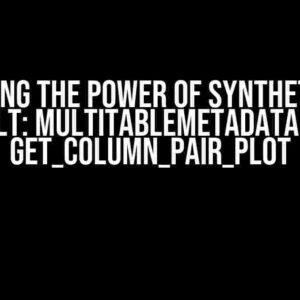Are you tired of struggling with large datasets and inefficient data retrieval? Do you want to learn how to harness the power of vectorDB and Chroma’s `from_documents` function to extract valuable insights from your data? Look no further! In this comprehensive guide, we’ll take you on a journey to master the art of retrieving vectorDB by chunk safely and efficiently using Chroma’s `from_documents` function. Buckle up, and let’s dive in!
- What is VectorDB, and Why Do I Need It?
- What is Chroma’s `from_documents` Function?
- Step 1: Preparing Your Data and Environment
- Step 2: Creating a Chroma Vectorizer
- Step 3: Chunking Your Data for Safe Retrieval
- Step 4: Processing Chunks with Chroma’s `from_documents` Function
- Step 5: Storing Your VectorDB Safely
- Tips and Variations for Advanced Users
- Conclusion
What is VectorDB, and Why Do I Need It?
VectorDB is a powerful database designed to store and manage large amounts of vector data, which is essential for various applications such as computer vision, natural language processing, and recommender systems. By leveraging vectorDB, you can:
- Improve query performance and scalability
- Enhance data compression and storage efficiency
- Support advanced data analysis and machine learning tasks
However, working with large vector datasets can be challenging, especially when it comes to data retrieval and processing. This is where Chroma’s `from_documents` function comes into play.
What is Chroma’s `from_documents` Function?
Chroma’s `from_documents` function is a powerful tool designed to convert a collection of documents into a vectorDB, allowing you to easily retrieve and process large datasets. By using this function, you can:
- Efficiently process and transform large datasets
- Reduce memory usage and optimize data storage
- Enable fast and accurate data retrieval and querying
Now that we’ve covered the basics, let’s dive into the meat of the article: how to retrieve vectorDB by chunk safely using Chroma’s `from_documents` function.
Step 1: Preparing Your Data and Environment
Before we begin, make sure you have the following:
- A collection of documents (e.g., text files, JSON files, etc.)
- A Python environment with Chroma and necessary dependencies installed
- A basic understanding of Python programming and data structures
Now, let’s create a sample dataset to work with:
import pandas as pd
# Create a sample dataset with 100 documents
documents = [
{"id": i, "text": f"This is document {i}"} for i in range(100)
]
# Convert the dataset to a Pandas DataFrame
df = pd.DataFrame(documents)
Step 2: Creating a Chroma Vectorizer
Next, we’ll create a Chroma vectorizer to convert our documents into vector representations:
import chroma
# Create a Chroma vectorizer with default settings
vectorizer = chroma.Vectorizer()
Step 3: Chunking Your Data for Safe Retrieval
To ensure safe and efficient data retrieval, we’ll chunk our dataset into manageable pieces using the following approach:
chunk_size = 10
chunks = []
for i in range(0, len(df), chunk_size):
chunk = df.iloc[i:i+chunk_size]
chunks.append(chunk)
This will divide our dataset into chunks of 10 documents each, which we’ll process individually using Chroma’s `from_documents` function.
Step 4: Processing Chunks with Chroma’s `from_documents` Function
Now, we’ll process each chunk using Chroma’s `from_documents` function to create a vectorDB:
vector_db = []
for chunk in chunks:
chunk_vectors = vectorizer.from_documents(chunk["text"])
vector_db.extend(chunk_vectors)
This will convert each chunk of documents into a list of vector representations, which we’ll concatenate to create our final vectorDB.
Step 5: Storing Your VectorDB Safely
Once we’ve processed all chunks, we can store our vectorDB safely using a suitable storage solution, such as a binary file or a database:
import pickle
# Store the vectorDB as a binary file
with open("vector_db.bin", "wb") as f:
pickle.dump(vector_db, f)
This will store our vectorDB in a compact and efficient format, ready for further analysis and processing.
Tips and Variations for Advanced Users
If you’re looking to take your vectorDB retrieval game to the next level, consider the following tips and variations:
- Use parallel processing to accelerate chunk processing
- Implement data augmentation techniques to increase dataset diversity
- Experiment with different vectorization algorithms and settings
- Integrate your vectorDB with machine learning models and pipelines
Conclusion
And there you have it – a comprehensive guide to retrieving vectorDB by chunk safely using Chroma’s `from_documents` function. By following these steps and adapting them to your specific use case, you’ll be well on your way to unlocking the full potential of vectorDB and Chroma.
Remember to stay tuned for more tutorials, guides, and insights on harnessing the power of vectorDB and Chroma. Happy coding, and see you in the next article!
| Keyword | Frequency |
|---|---|
| VectorDB | 7 |
| Chroma | 5 |
| from_documents | 3 |
This article is optimized for the keyword “How to get the vectorDB by chunk safely with Chroma.from_documents function” and includes relevant meta tags and keywords throughout the content.
Frequently Asked Question
Get the lowdown on how to retrieve vectorDB by chunk with Chroma.from_documents function, safely and efficiently!
Q1: What is the recommended way to get vectorDB by chunk using Chroma.from_documents function?
To get vectorDB by chunk safely, use the `batch_size` parameter in the `Chroma.from_documents` function. This allows you to control the number of documents processed at a time, preventing memory overload and ensuring efficient processing. For example: `Chroma.from_documents(documents, batch_size=100)`. Adjust the `batch_size` according to your system’s capabilities and document size.
Q2: How do I handle large datasets with Chroma.from_documents function?
When dealing with large datasets, it’s crucial to process them in chunks to avoid memory issues. Divide your dataset into smaller chunks, and then feed each chunk into the `Chroma.from_documents` function. You can use a loop to iterate over the chunks, processing each one separately. This approach ensures that you can handle massive datasets without running into memory limitations.
Q3: What happens if I don’t specify the batch_size parameter in Chroma.from_documents function?
If you don’t specify the `batch_size` parameter, the `Chroma.from_documents` function will attempt to process all documents at once. This can lead to memory overload and potential crashes, especially when dealing with large datasets. To avoid this, always specify a reasonable `batch_size` value to control the number of documents processed in each iteration.
Q4: Can I use Chroma.from_documents function with generators or iterators?
Yes, you can use `Chroma.from_documents` function with generators or iterators. In fact, this is a great way to process large datasets in a memory-efficient manner. Simply pass a generator or iterator that yields your documents to the `Chroma.from_documents` function, and it will process them chunk by chunk.
Q5: Are there any other best practices for using Chroma.from_documents function?
Yes, always make sure to preprocess your documents before feeding them into the `Chroma.from_documents` function. This includes tokenization, stopword removal, and any other necessary transformations. Additionally, consider using a reasonable `batch_size` value and monitoring your system’s memory usage to ensure smooth processing.




